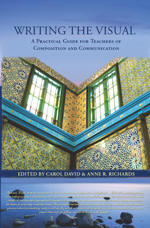|

There are
few examples from this collection of essays that have sparked my
interest. Particularly, I feel that the following have
made me, more so than the others, reflect on my own classroom
practices in a positive way.
Although I have seen similar assignments
in other writing pedagogy texts,
the assignment described by L. J. Nicoletti in
Chapter 3, the memorial design project, is one that I feel
has great potential for those who have or who have not
implemented visual rhetoric instruction in a writing classroom.
The idea of rereading visual spaces, in particular those that
have been designed to memorialize events in history, is an
interesting concept in that it calls into questions those voices
that have gone unheard. I feel this assignment would work
to encourage students to consider marginalized voices. It
would also mean asking students to
be active in rewriting historic places and creating new ones.
Practically speaking, I think such an assignment would work
nicely in an upper level writing classroom; however, it could
be modified for lower level writing classrooms as well.
Like many of the other assignments in Writing the Visual,
Worthington and Rard's documentary film analysis assignment in
Chapter 4 can be adapted to suit the goals of many other
courses, including composition courses.
While they describe their assignment in the context of a
first-year writing course, it could certainly work for a course
which not only asks students to rhetorically analyze a
documentary film, but also asks students to compose their own
documentary film. For instance, in a digital rhetoric
class, this particularly assignment could be used as a beginning
point from which other assignments, such as a documentary film
design assignment could build upon.
Asking students to think more critically about race and racism
seems to be a central theme in many of the chapters in this
book, particularly because race and racism is often portrayed
unquestionably in images. "Race moves," King writes in
Chapter 5. "It moves people." And, often
it moves people by way of images. In my own classroom, I
usually assign students a project that involves analyzing visual
arguments. Sometimes, students examine images that further
racial stereotypes and we discuss our readings of these images
in class. But, I've recognized that to get them to achieve
a deeper understanding of race and racism is often difficult,
especially because sometimes students feel uncomfortable.
King's approach to teaching a racial metaphors module, one that
progresses through a series of exercises, might help to ease
some of the tension by students might feel.
Finally,
Wei's discussion of the differences between the construction of
ethos in Western and Chinese cultures in Chapter 8 made me want
to rethink my approach to teaching ethos in the writing
classroom. I appreciate Wei's comparison
between Classical Chinese rhetoric and what he calls bamboo
hypertext. Classical Chinese rhetoric and bamboo
hypertext, as Wei clarifies, are similar because both are
"nonlinear, open ended, collective, multi-accentual,
interactive, and networked" (p. 151). The point in making
this comparison is to further delineate why Chinese rhetoric
differs from Western rhetoric. Too often, as a writing
instructor, I have instructed my students to analyze texts by
way of asking them to think of ethos in terms of how the
individual created a sense of credibility or authority within
the text. In doing so, however, I failed to ask students
to think about ethos in terms
of constructing it in view of the collective. Wei's sample
assignment serves as an example of a cross-cultural approach in
comparing how Western and Chinese cultures create ethos
differently online and could easily be managed in a writing
classroom.


|
